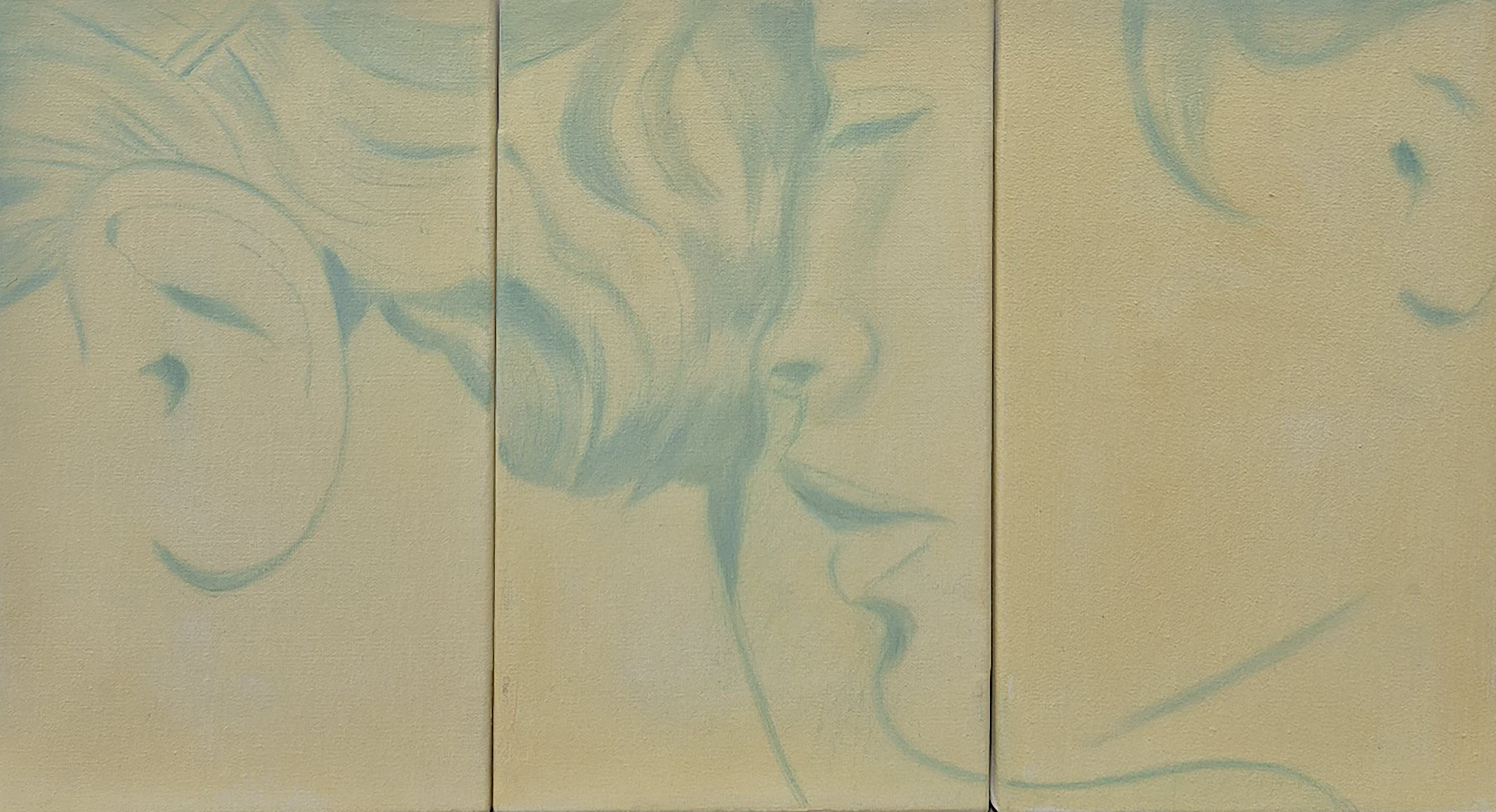Counterfactual
2023. 11. 13 - 11. 30 | [GALLERIES] Wellside Gallery
제이슨 황

Jason Hwang, David Bowie was here yesterday. 2018. Archival pigment print, 81 x 54 cm
나를 바라보는 피사체들은 내 자신을 반영한다. 그들의 얼(soul)은 각기 삼라만상(universe)의 거울이기에 자신들은 사실 그 우주에 비친 내(관찰자) 모습이라고, 하늘을 연분홍으로 물들이며 걷던 여자가 말을 건넨다. 그것을 믿는다면, 서로 마주보는 한 쌍의 거울처럼 나와 피사체 사이엔 미궁의 공간이 생성된다. 사물은 음音의 메아리이며 음은 사물의 과거이다. 그녀는 미래를 그리워한다. 그곳에서 왔기 때문일 것이다. 오래된 내일의 쓰디쓴 상처와 먼 훗날에 대한 향수鄕愁를 품고 사는 부류이자 때묻지 않은 과거의 도래를 기다리는 그녀는 별안간 눈앞에 나타나 붉게 타던 석양이 지평선 이면의 아케론으로 낙하하듯 순식간에 자취를 감췄다. 귓속으로 밀려드는 슈프레(Spree)의 노래가 숲처럼 서늘했다. 그 한 해 전 텍사스의 어느 작은 마을 교회에서 올린 멕시코인들의 결혼식. 장미 꽃잎을 흩뿌려 둔 중앙 통로를 중심으로 양쪽에 늘어선 신도석 벤치 측면엔 흰 꽃으로 정성스레 장식한 라벤더색 망사 천이 줄줄이 드리워져 있었다. 주례사를 마치고 얼굴 반쪽이 찰과상으로 전부 시커멓게 흉이진 소년과 몇 마디 대화를 나눈 뒤 걸어 나오던 목사는 낯빛이 구아바 속살처럼 수줍게 들뜬 그곳의 유일한 백인이다. 입을 꾹 다문 채 엄숙하게 퇴장한 그가 지나간 자리엔 천둥소리와 탄식의 동요가 여진처럼 남았다.
마치 자석 주변의 철가루가 자기장에 사로잡혀 일제히 몸을 꼿꼿이 일으켜 세우고 원형으로 자석을 에워싸듯, 이 두 장면을 사이에 두고 일련의 이미지들이 팽팽하게 조응한다. 시차를 두고 촬영된 저 모든 정경들은 이를테면 동일한 시공간 속에 점점이 흩어져 있다. 시간은 결코 한 방향으로 날아가는 화살이 아니다. 그것은 눌러앉고 둘러싸이며 더해진다. 반복 교차하는 우연에 의해 SO36으로 빨려 들어간 나는 그 시간의 덩어리 속에서 무한한 선택지 중 조금씩 서로 다른 길들을 택한 복수의 나로서 지금도 살아 숨쉬고 있을 것이다. 그리고 그들은 밤이 오면 장래의 시점으로 떠나온 나를 향해 머리를 베고 누울지 모른다. 바로 그 어두운 공연장에서 젊은 날 음악을 하던 창백한 얼굴의 데이빗 보위는 대서양을 건너 또 시간을 역으로 거슬러 새하얀 생일 케익 속에 삼원색으로 선명하게 박혀 있었다.

Jason Hwang, Ebtitel. 2018. Archival pigment print, 130 x 86.7cm
그해 겨울 맨하탄에서 만난 서커스 곡예사는 환하게 웃는가 싶다가도 이내 한없이 무심한 표정을 지었다. 이 모두가 어쩌면 잃어버린 것들을 찾아다니는 놀음인지 모른다. 상실한 것들이 우리를 끌어당기는 쪽으로가는 것일 수도 있다. 현재와 “만약” 사이를 공중그네 타는 일일지도. 금발의 동양인과 딸기색 머리 여자친구는 입을 모아 세상에서 가장 아름다운 은빛의 담배연기를 허공을 향해 길고 두텁게 내뿜었다. 이들은 물론, 비뚤배뚤 일그러진 궤적으로 새빨갛게 립스틱을 칠한 펑크족과, 축구경기를 마치고 붉은 대문 아래 앉아 잠시 숨을 돌리는 붉은색 셔츠의 고교 소녀들 모두가 들숨 날숨으로 시공간을 직조한다. 침전음은 대기로 환원된다. 나는 바다 앞에 다시 서있다. 수평선을 노려보는 갈매기와 그들의 머리깃을 헝클어 놓는 바람과 파도소리, 바다의 충실한 부속물들을 찾아서. 끝없이 열려 있는 무경계의 전방을 응시하기 위해.
욕망의 대상을 향해 손을 뻗어 만지고 입으로 넣어 삼키고 싶은 것이 바라본다는 행위의 요체이다. 손에 잡히는 대로 우선은 목구멍으로 우겨 넣고 보고 싶은 것이다. 카메라 안에 무작정 잡아 놓고 보는 것이다. 스스로 쌓아 올린 요새 속에 끝내 자신을 격리해 버리는 것처럼. 그러면서도 막힘없는 저 바깥 세상을 그리워하는 이율배반, 그 서글픈 습성처럼. 나는 젊기도 늙기도 한 저 광경들 틈으로 유영하며 눈을 깜박여 그 풍경을 뇌리에 가두려 한다. 그라핑, 베를린, 맨하탄, 베니스, 드레스덴, 서부텍사스 등의 불특정한 경관과 부속음들은 무의식의 은실로 꿰어져 있다. 지구본을 만들기 위해 재단된 평면도 조각들을 이어 붙이듯, 나뉘어진 칸에 하나 둘 채워 넣을 이들 무작위적 장소가, 그리고 그곳에 인화된 피사체들이 어느새 하나의 행성으로 거듭난다. 일견 랜덤한 좌표들은 저마다 음을 따라서 묵묵히 특정되고 지각知覺의 심연을 통해 굴절되어 비가시적인 유형有形의 세계로 현현顯現한다.

Jason Hwang, Fort Galveston. 2018. Archival pigment print, 100 x 66.7 cm
시선이 가 닿는 곳에는 눈을 감지 않아도 들리는 소리들이 있다. 아주 오래된, 첩첩이 덧붙여진 음(mousikē)이다. 잠자리에 들 시간이 되면 꺼내어 마음을 움직이는 소리들을 적었던, 목침 깊숙이 돌돌 말아 둔 세이쇼나곤의 일기장처럼, 나의 사진은 보이지 않는 칸막이 너머의 소리(그리고 그것이 머무는 영상)를 가둘 비망록과 다르지 않다.
Jason Hwang은 동경과 뉴욕에서 상학과 경제학을 전공하고 워싱턴 소재 세계 최대의 국제개발기구에서 근무하며 아시아, 아프리카, 라틴아메리카, 중동 등의 광범위한 지역을 아우르는 국제개발 업무를 담당했다. 재즈와 클래식 음악, 카메라를 벗삼아 성장한 유년기부터 끊임없이 이동해야 하는 노마드로서 해외에서 대부분의 삶을 보내면서 아이덴티티와 다중리듬적인 비주얼 언어가 사진작업의 중요한 요소로 작용하게 되었다. 그의 사진은 지속되지 않는 것의 덧없음과, 작가 특유의 기질이 혼합된 일기적 요소를 내재하고 있기도 하다. 때때로 예상치 못한 주제나 기묘한 친숙함을 병치하고 비뚤어진 각도의 구도로 일상의 불안정하고 진솔한 실상을 묘사함으로써 동요動搖의 파동을 함축한 이미지를 이끌어낸다. 그의 작품은 피사체가 실제로는 작가를 바라보는 관객이며, 더 나아가 작가를 거울처럼 비추는 데 그치지 않고 존재 자체를 담아낸다는 것을 암시한다. 그러므로 카메라 렌즈를 사이에 두고 작가와 피사체가 주고받는 상호응시하는 시선은 둘이 아닌 하나라고 작가는 말한다. 본 전시 Counterfactual은 “그렇게 되지 않았지만 그렇게 되었을지도 모를” 세계이며 현실세계의 비가시적 지층을 이루고 있는 시공에 대한 모색이다. 이미지와 소리가 분리되지 않는 미로와도 같은 공간에 대한 작가의 탐색이 남긴 실마리이기도 하다.
샘터화랑
서울시 서초구 고무래로 8길 4
02-514-5122
[GALLERIES] Wellside Gallery
- Dates
- 2023. 11. 13 - 11. 30











